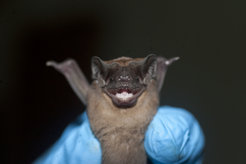Could a special immune system help protect bats from Ebola?
Bats frequently come into contact with infectious diseases, but surprisingly rarely suffer from them
The bat's immune system works in a fundamentally different way to that of other mammals. This was the conclusion reached by scientists from the Max Planck Institute for Ornithology in a study of mastiff bats. The research could also be significant in the fight against viral diseases that can be transmitted from animals like bats to humans.

While bats qualify as carriers and reservoir hosts of a whole range of infectious diseases, very little research has been conducted on their immune system to date. Researchers from the Max Planck Institute for Ornithology in Radolfzell, the University of Konstanz and the Smithsonian Tropical Research Institute in Panama are now trying to bridge this gap. Their findings show that the immune system of bats may work in a way that is fundamentally different to that of other mammals. The immune defence of the animals could even provide clues as to how certain infectious diseases can be averted.
Many of the 1,300 known bat species have antibodies in their blood to protect against various diseases but rarely have the pathogens themselves. The animals seem to be able to fight off the pathogens without becoming ill themselves. But what makes their immune system so special?
The scientists studied the immune responses of Pallas's mastiff bats (Molossus molossus) in Panama. The animals follow a specific daily routine: during the day they reduce their energy consumption in their roosts in order to save energy. During this period, the bats rest motionless and their body temperature drops. It's only at sunset, when the mastiff bats set out for the hunt, that they come to life. Now, their body temperature rises to more than 40 degrees Celsius as their muscles need to work hard during their flight.
However, the high temperature could also have a side effect: it could activate the immune response against pathogens as a type of daily fever. Conversely, the daily slowdown in their metabolic rate could also inhibit the proliferation of existing pathogens in the body.
To test this hypothesis, the researchers administered a lipopolysaccharide (LPS) – a compound, harmless in itself, made up of lipid and sugar components – to the bats. As LPS is also found on the outer membrane of many pathogens, the bat's immune system assumes a bacterial attack and switches to defence mode.
As the scientists demonstrated, however, the daily temperature fluctuations remained unchanged even after the administration of LPS. The material therefore does not trigger a fever in the bats, as it does in other mammals. Furthermore, the number of white blood cells in the blood – an indicator of the strength of the immune defence – did not increase. However, the bats did lose a significant amount of mass within 24 hours – a sign for the researchers that the animals mobilise energy reserves for the immune defence.
“This mass loss also occurs in other bat species,” explains Teague O’Mara, lead author of the study. “This is an indication that their immune system is switched on.” Up until now, however, nobody could say exactly which cellular processes were taking place. “The immune system in bats does not behave in the same way as in other mammals,” says Dina Dechmann from the Max Planck Institute for Ornithology. “We need to understand what makes it so special. It could help us to learn a lot about diseases that are dangerous to humans.”
Thus, it is conceivable that bats could be unjustly blamed for Ebola. In a survey, scientists from the Robert Koch Institute and the Max Planck Institute are systematically analysing the current level of knowledge about the origin of the Ebola virus. According to the researchers, fruit bats cannot be the main or only reservoir. The Ebola virus itself has not yet been established in bats.
The chain of evidence so far is based on antibodies against Ebola, which have been discovered in the blood of fruit bats. The animals therefore may well come into frequent contact with the virus but are in a position to fight it off. A similar situation could arise with other infectious diseases which can be transmitted from animals to humans, such as rabies. In this case as well, an effective immune system could protect the bats from becoming ill. “If we could understand how the animals cope with the diseases, we could use this knowledge to develop new vaccines and medications,” says O'Mara.
CB/HR












